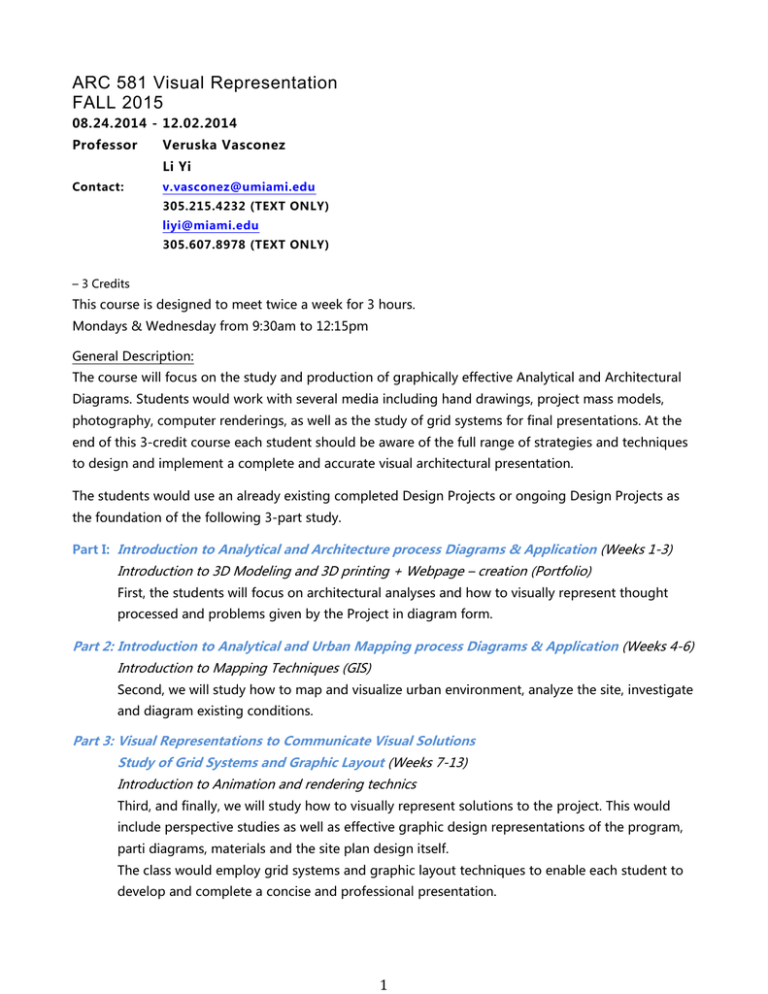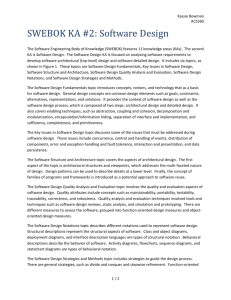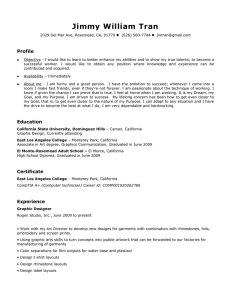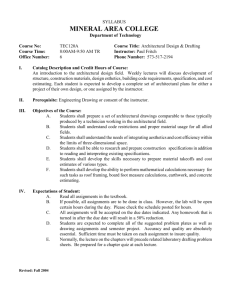File
advertisement

ARC 581 Visual Representation FALL 2015 08.24.2014 - 12.02.2014 Professor Veruska Vasconez Li Yi Contact: v.vasconez@umiami.edu 305.215.4232 (TEXT ONLY) liyi@miami.edu 305.607.8978 (TEXT ONLY) – 3 Credits This course is designed to meet twice a week for 3 hours. Mondays & Wednesday from 9:30am to 12:15pm General Description: The course will focus on the study and production of graphically effective Analytical and Architectural Diagrams. Students would work with several media including hand drawings, project mass models, photography, computer renderings, as well as the study of grid systems for final presentations. At the end of this 3-credit course each student should be aware of the full range of strategies and techniques to design and implement a complete and accurate visual architectural presentation. The students would use an already existing completed Design Projects or ongoing Design Projects as the foundation of the following 3-part study. Part I: Introduction to Analytical and Architecture process Diagrams & Application (Weeks 1-3) Introduction to 3D Modeling and 3D printing + Webpage – creation (Portfolio) First, the students will focus on architectural analyses and how to visually represent thought processed and problems given by the Project in diagram form. Part 2: Introduction to Analytical and Urban Mapping process Diagrams & Application (Weeks 4-6) Introduction to Mapping Techniques (GIS) Second, we will study how to map and visualize urban environment, analyze the site, investigate and diagram existing conditions. Part 3: Visual Representations to Communicate Visual Solutions Study of Grid Systems and Graphic Layout (Weeks 7-13) Introduction to Animation and rendering technics Third, and finally, we will study how to visually represent solutions to the project. This would include perspective studies as well as effective graphic design representations of the program, parti diagrams, materials and the site plan design itself. The class would employ grid systems and graphic layout techniques to enable each student to develop and complete a concise and professional presentation. 1 The course would also include parallel lectures on typography, architectural graphic design, and verbal presentation. The lectures will be given by highly regarded industry professionals who will address the way that the students can be aware of and understand typography, verbal presentation, and graphic design fundamentals as it relates to architecture. Grading Policy: Participation 20% Projects 50% Class Work 20% Final Presentation 10% Attendance Policy: The University of Miami has no provision for unexcused absences. Attendance at all classes is expected. All excuses are to be submitted in writing via e-mail the instructor as well as to Jude Alexander for approval. More than three unexcused absences is an automatic 'F' for the course. Unexcused absence on presentation or review days is an automatic 'F' for the assignment. More than three times that you are late (by more than 5 minutes) will equal one unexcused absence. You must notify the instructor within the first two weeks of the course if you will be absent for holy days for any religion (travel time does not count as a holy day). Participation: Participation requires active listening, speaking, asking questions, and engaging the material, as well as the comments of your colleagues. Please note that there will be differences of opinion during the discussions and to treat your colleagues with respect and professional decorum. Professional Ethics: Cheating and plagiarism will NOT be tolerated. Students are bound by the University’s honor code in all their work. Plagiarism is the misrepresentation of someone else’s ideas or work as your own and includes (but is not limited to) the cutting and pasting of images, sentences, phrases, or paragraphs without proper citation as well as the stating of another person’s ideas or conclusions as your own without proper citation. If plagiarism is suspected, appropriate action will be taken and may result in failure of the course or possibly removal from the school. If you have any questions or concerns about plagiarism, contact the professor, reference the honor code for graduate students, or visit the Writing Center. The UM Writing Center: http://www.as.miami.edu/writingcenter or call 305-284-2956 for an appointment Chicago Manual of Style-- http://www.chicagomanualofstyle.org/home.html—also available online through the UM Library. Software: 2 Rhino and Grasshopper is required if students wish to work on their own laptops. A free 90 day trial can be downloaded via https://www.rhino3d.com/download. All lab computers have Rhino and Grasshopper ready to deploy. ArcGIS Pro is required to complete the mapping and analysis tasks. The software can be downloaded via http://pro.arcgis.com/en/pro-app/. The authorization codes that are valid for one year will be emailed to students. A Responsible Architecture A responsible architecture is one that takes into consideration aesthetics, ecology, sustainability, history, context (urban or otherwise), as well as the health, welfare, and joy of the people who occupy it. This course will address architecture from a distinctly humanist viewpoint, but keeping in mind how man is inextricably connected to the environment, both architectural and natural. To focus on sustainability or typology or urbanism or aesthetics alone would be to negate that field of interconnectedness. The creation of a responsible architecture requires this multi-layered approach. 3 COURSE SCHEDULE: Part I: Introduction to Analytical and Architecture process Diagrams & Application (Weeks 1-3) wk1: 08.24 – 08.26 Introduction Class Introduce First Project (Prof. Hector) Website Rhino The instructors would bring examples of analytical, architectural diagrams that effectively explain thought process, as well as diagram the problems given by the project. The instructors will introduce architectural applications of Photoshop, Illustrator and Rhino for 3D modeling task. A list of weekly reading will be introduced to students, every Monday one to two students will be asked to present verbally and graphically the reading of choice. wk2: 08.31-09.02 Reading I due: 20min presentation I Hippocrates, “On Airs, Waters, and Places,” in Hippocrates, Vol. 1. Cambridge & London: Harvard and Heinemann, pp. 71-95. Lecture 1:“Effective Verbal Presentation” 08.31 at 10am 1 hour duration Students will bring Studio Design Project in progress, to apply effective application of analytical a diagrammatical exercises. The Instructor would conduct the class in desk crit manner to ensure that each student understands the applications. Students will be asked to compose (2) 24”x 36” layouts of analyses and diagrams using various media and prepare 3d models for Makerbot 3d printer. The assignment shall be uploaded in PDF format and presented in hard copy format at the end of week3. wk3: 09.09 Reading II due: 40min presentation II Le Corbusier. “The Lesson of Rome,” Towards a New Architecture. Dover Publications, INC, 1986: 149-174. III Allan T. Shulman. “Miami Beach as Urban Assemblage: A Unique Culture of Housing,” The New City: Modern Cities, ed. Jean-Francois LeJeune. Coral Gables: 1996: 25-49. Part I Final - 2 reviewers will join the class to analyze and discuss the work. After the review students will have 5 days to make final corrections and review the final layout of their presentation and models. Assignments shall be uploaded on the server, as well as on their website, printed and hand delivered in the following class. 4 Part 2: Introduction to Analytical and Urban Mapping process Diagrams & Application (Weeks 4-6) wk4: 09.14– 09.16 Reading IV due: 20 min presentation IV Alan Colquhuon. “Typology and Design Method”, in Nesbitt or Essays in Architectural Criticism or Perspecta 12. Introduction to Mapping Techniques (GIS) Introduction to Site Analysis The instructor will bring examples of visual representations that effectively communicate Urban Mapping and Analysis. Additionally, we will study effective graphic design representations of each element of the site plan. Students would be asked to research and bring 3 distinctive examples of architectural visual proposals and solutions that are represented by urban design diagrams. Specifically, 2D and 3D site plan diagrams, flora and fauna analysis, water rising, and site section analysis produced by hand, model, or computer software. Assignment shall be formatted on 11”x 17” layouts and presented at the end of following week. wk5: 09.21 – 09.23 Reading V - VI due: 40 min presentation V William Ellis. “Type and Context in Urbanism: Colin Rowe’s Contextualism,” Oppositions Reader, 227-251. VI Rem Koolhaas, “The Generic City,” SMLXL, 1238-67. Introduction to Advanced Mapping Techniques (GIS) Introduction to Prezi Presentation Students shall continue with work from previous week followed by desk crits and learning of advanced mapping techniques. On Wednesday students will present their assignment during the first hour of class. wk6: 09.28 – 09.30 Reading VII due: 20 min presentation VII Robert Venturi, Denise Scott Brown, Steven Izenour, “Part 1,” Learning from Las Vegas (Boston 1972), 1-83.Lecture 2: “Architectural Graphic Design” Students shall continue with work from previous week followed by desk crits. Part II Final - On Wednesday during the review of assignment, two guest critics will be invited to participate and students will be asked to verbally present their one paragraph description as well as their (36”x 72”) composed layout printed and Prezi format presentation. Guest Lecture by Prof. Alberto Cairo: “Functional Data Art” 5 Part 3: Visual Representations to Communicate Visual Solutions Study of Grid Systems and Graphic Layout (Weeks 7-13) wk7: 10.05 – 10.07 Reading VIII due: 20 min presentation VIII “Peter Eisenman versus Leon Krier: My Ideology is Better than Yours,” AD 59:9-10 (1989), 6-18. Introduction to Algorithmic Modeling – Grasshopper Component The instructor will bring examples of visual representations that effectively communicate solutions to various architectural projects. Additionally, we will study effective graphic and digital design representation of each element of the program. For applications, students will start learning fundamentals of Grasshopper component. Lecture 2: “Architectural Graphic Design” 1 hour duration wk8: 10.12 – 10.14 Reading IX- X due: 40 min presentation Anthony Vidler. “The Idea of Type: The Transformation of the Academic Ideal, 17501830, Oppositions Reader, 439-459. X Adrian Forty. “Type” Words and Buildings. A Vocabulary of Modern Architecture. London: Thames and Hudson: 2004: 304-311. The Instructor will give an exercise to be produced and developed during class time. Students will be asked to form teams to develop an urban design diagram, a program analysis in 2D and 3D, floor plan parti diagram, 2 section analyses, as well as a grasshopper generated 3D site model. A pin up and 3D model review will take place at the end of following week and students will have the opportunity to critique their colleagues’ proposals. Groups will have until the next class meeting to improve and correct the hand drawings, site models and proposals. Each drawing shall be scanned and presented individually on 11”x 17” layouts in PDF format. Students shall continue with work from previous week followed by a desk crit. wk9: 10.19 – 10.21 Reading XI due: 20 min presentation XI Robin Evans. “Seeing Through Paper,” The Projective Cast: Architecture and Its Three Geometries. Cambridge, MA: The MIT Press, 1996: 107-21. Students shall continue with work from previous week followed by a desk crit. On Wednesday students will present their assignment during the first hour of class. 6 Wk10:10.26 – 10.28 Reading XII due: 20 min presentation XII Charles Jencks, “Part 2: Two Modes of Communication,” The Language of Post Modern Architecture (1977), 38-79. On Monday students will present their assignment during the first hour of class. Using the same drawing assignment from the previous week, students will be asked to develop renderings using hand drawings as well as mass models. Working with a combination of different media, students will achieve a more complex and complete graphic representation. Students will explore Photoshop, Illustrator, Rhino (Grasshopper) software. The instructor will conduct the class in a desk critique manner and teach the application of different techniques. Students will have to submit (4) 11”x17”sheets of their final work by the beginning of following week. Wk11:11.02 – 11.04 Reading XIII due: 20 min presentation XIII Daniel Horowitz, Consuming Pleasures: Intellectuals and Popular Culture in the Postwar Period (2012), 350-9. On Monday students will present their assignment during the first hour of class. Using the same Design Project from Wk 8 and 10, the students will be asked to apply methods of effective graphic design, previously demonstrated by the instructor and exercised by the students to effectively communicate visual solutions. The class would study a list of analytic and diagrammatic architectural drawings provided by instructor, which will reflect all techniques learned by the students in the previous 10 weeks of the course. Students will compose (8) 11”x17” layouts in PDF format. They will have 2 weeks to complete all drawings requested by the instructor, as well as to develop one written paragraph introducing their project. Students shall continue with work from previous week followed by desk crits. Wk12: 11.09 – 11.11 Reading XIV due: 20 min presentation XIV Rosalind Krauss, “Sculpture in the Expanded Field,” October, Vol.8 (spring 1979), 30-44 Students shall continue with work from previous week followed by desk crits. Wk13: 11.16– 11.18 XV Rem Koolhass, “The Skyscraper Theorist,” Delirious New York (1994), 110-131. Lecture 3: “The ABC’s of Typography”, to provide a better perspective on the fundamentals of typography as it relates to Architectural layouts and presentations. 7 1 hour duration The instructor provides examples of effective visual grid systems and architectural graphic layouts for review and discussion. The students will be asked to create two 36” x 72” presentation boards, composed of drawings and mass models that were developed in previous weeks, applying a visual grid system and an effective graphic layout. On Wednesday review of assignment. Two guest critics will be invited to participate and students will be asked to verbally present their one paragraph description as well as their (8) composed layouts in a PDF format. Wk14: 11.23 – 11.25 THANKSGIVING Wk15: 11.30 FINAL REVIEW 12-02 8




